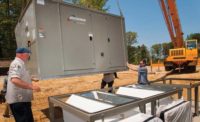In the last few years, the commercial refrigeration space has seen a significant shift toward natural hydrocarbon (HC) refrigerants thanks to new and proposed regulations.
While that change may not yet be readily apparent to dealers and distributors, what will be noticeable is OEMs using this transition as an opportunity to really correctly size their equipment to ensure refrigeration systems operate more efficiently and are compliant with legislation trends.
Even though the Environmental Protection Agency’s 2018 SNAP Rule 20 restricting the use of HFCs in retail and foodservice applications was struck down by the courts, several U.S. states have adopted the EPA’s recommended phasedown, pushing OEMs toward natural refrigerants such as R-290 and R-600a.
The benefits of R-290
Most self-contained compressor applications under 1 HP are already using R-290 propane as the refrigerant of choice. R-290 offers a significant energy benefit over legacy HFC refrigerants and is an easy way to meet the DOE’s 2017 energy regulations while remaining competitive.
R-290 arrangements operate with a lower refrigerant charge, at lower temperatures and pressures. In addition to less noise, the lower stress of these designs provides enhanced reliability and longer lifespans.
Evolving R-290 standards and best practices
The IEC recently updated its rules around flammable refrigerants to allow the use of up to 500g of R-290 in systems for self-contained commercial applications, such as icemakers. Over the next few years, ASHRAE and UL will be updating their standards around HC refrigerants to allow OEMs to use these increased charges. This, in turn, will allow more types of self-contained plug-in equipment to use HC refrigerants.
The move to less-familiar hydrocarbon (HC) refrigerants does mean that dealers and distributors may be hearing more concerns from contractors about flammability. To address these concerns, dealers and distributors need to stay familiar with current regulations and do their best to educate their customers on proper safety practices.
Although propane and other HC refrigerants are flammable, the refrigerant charge of most household and light-commercial applications is equivalent to two or three cigarette lighters. It’s also important to educate people on safety standards, as the dangers of working with flammable gases can be highly mitigated if the proper procedures are followed:
- Always keep the work area well-ventilated to avoid gas accumulation;
- Always use a hydrocarbon detector, vacuum pumps and appropriate pressure gauges; and
- Always use a safety placard to indicate that you are working with flammable gas.
Natural refrigerants and variable-speed compressors
The switchover to natural refrigerants also means a move away from systems with large refrigerant charges and oversized compressors. As OEMs redesign their products for use with HC refrigerants, they also are incorporating variable-speed compressors and smart controllers that enable systems to perform more efficiently in extreme conditions and still meet the requirements of all energy regulations.
Improving the efficiency of the refrigeration circuit helps OEMs control costs and remain competitive, but more importantly, it lets them offer energy savings and smaller compressor footprints. Whether prompted by regulations or innovation, for the end user, the benefits are the same: Lower overhead costs and more merchandising space.
Natural refrigerants will continue to become more ubiquitous across the commercial refrigeration space throughout 2020 and beyond. The best way dealers and distributors can stay ahead of the curve is to stay educated on the latest uses, benefits, standards and best practices, particularly as it relates to R-290.




